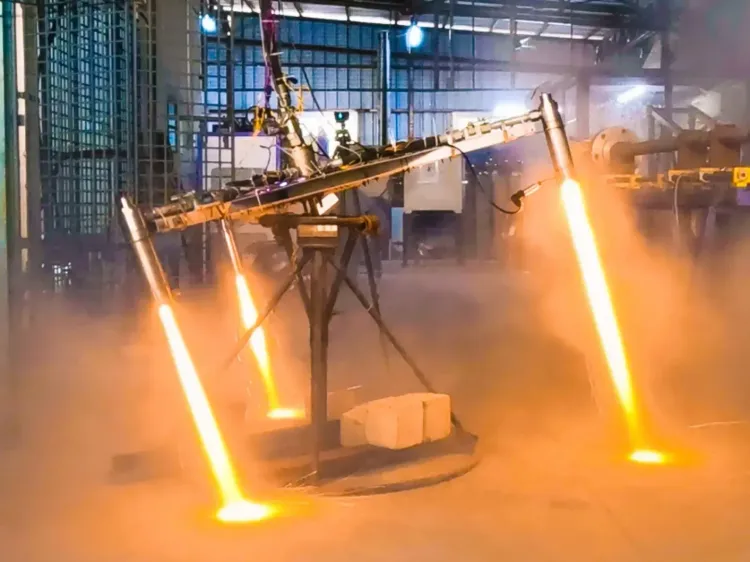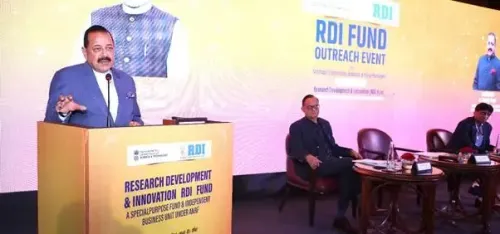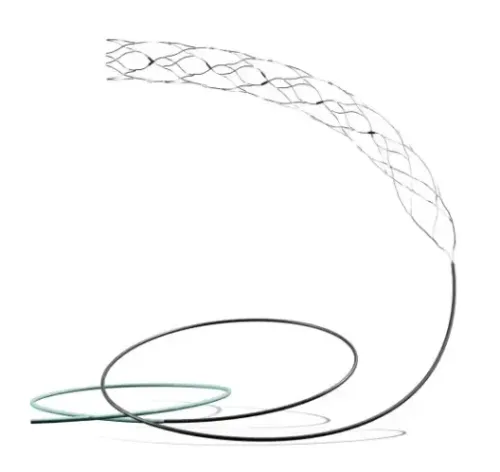How is IIT Madras Revolutionizing Vertical Take-Off and Landing with Hybrid Rocket Thrusters?

Synopsis
Key Takeaways
- Hybrid rocket thrusters offer a safer and simpler alternative for VTOL systems.
- The research emphasizes the importance of touchdown velocity for safe landings.
- Decentralized air transport could enhance access to remote locations.
- Innovative HILS frameworks are pivotal for rapid system development.
- Hybrid rocket fuel using compressed air as an oxidizer simplifies integration.
Chennai, Oct 30 (NationPress) Researchers at the Indian Institute of Technology (IIT) Madras have propelled India closer to the forefront of vertical take-off and landing (VTOL) technology for both aircraft and Unmanned Aerial Vehicles (UAVs) utilizing hybrid rocket thrusters.
In a groundbreaking experiment that merged real-time hybrid rocket thruster technology with virtual simulations, the team successfully attained the required velocity for a ‘soft landing’—a vital aspect for various crafts, from planetary exploration modules to terrestrial VTOL aircraft.
The touchdown velocity is critical to ensuring safe vertical landings.
Researchers explored the potential of hybrid rocket motors for vertical landing platforms, noting they are simpler and safer than traditional liquid engines. Additionally, hybrid rocket systems are increasingly favored for their safety, throttling capabilities, and the ability to merge the benefits of both liquid and solid rocket propulsion.
Currently, existing VTOL systems are complex and demand high maintenance. Therefore, the study, recently published in the peer-reviewed International Journal of Aeronautical and Space Sciences, introduced the concept of a hybrid rocket thruster-driven platform as part of a developmental study aimed at creating an efficient propulsion unit for achieving VTOL in aircraft and UAVs.
“The term vertical take-off and landing means that an aircraft can ascend and descend vertically, removing the necessity for extensive infrastructure such as long runways. This capability will facilitate access to remote and rugged areas where establishing large airports is impractical. Presently, helicopters operate in these environments, but they are limited in speed, range, and efficiency when compared to fixed-wing aircraft,” stated Prof. PA Ramakrishna from the Department of Aerospace Engineering at IIT Madras.
“Once the VTOL technology reaches the Technology Readiness Level (TRL) for commercial use, it could revolutionize both civil and military aviation. VTOL technology will decentralize air transport, allowing for operations in multiple locations rather than relying solely on major airports or airbases. This decentralization offers substantial strategic and operational benefits. This research is a vital step towards developing and demonstrating a proof-of-concept for a hybrid rocket-powered VTOL platform,” Ramakrishna continued.
Experts pointed out that a significant advancement is the creation of a hybrid rocket fuel that only requires compressed air as an oxidizer, making VTOL systems easier to integrate with aerospace vehicles, particularly in situations where compressed air is readily accessible.
“Another intriguing aspect of this research is the innovative Hardware-in-the-Loop Simulation (HILS) framework developed by the IIT Madras team. HILS integrates physical hardware testing with simulations, providing an economical method to rapidly develop complex systems,” explained Dr. Joel George Manathara, Associate Professor in the Department of Aerospace Engineering at IIT Madras.
He elaborated that while typical HILS setups involve a servo motor or microcontroller interacting with simulations, their team incorporated a live, firing hybrid rocket motor directly into the HILS loop.
The hardware-in-the-loop simulation setup successfully demonstrated a soft landing of the platform with a touchdown velocity of under 1 m/s.










